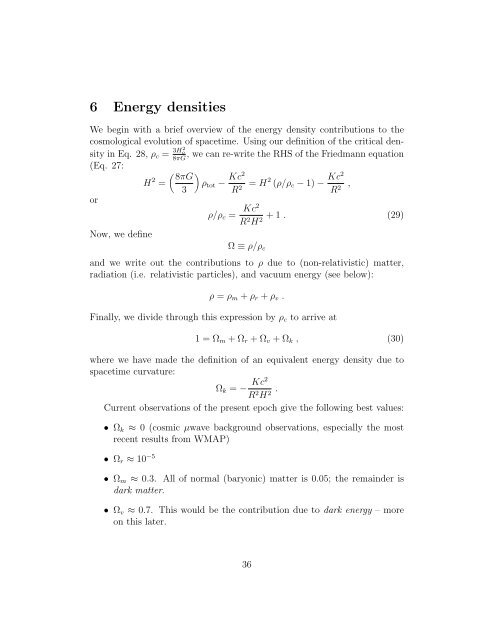Lecture Notes for Astronomy 321, W 2004 1 Stellar Energy ...
Lecture Notes for Astronomy 321, W 2004 1 Stellar Energy ...
Lecture Notes for Astronomy 321, W 2004 1 Stellar Energy ...
Create successful ePaper yourself
Turn your PDF publications into a flip-book with our unique Google optimized e-Paper software.
6 <strong>Energy</strong> densities<br />
We begin with a brief overview of the energy density contributions to the<br />
cosmological evolution of spacetime. Using our definition of the critical density<br />
in Eq. 28, ρ c = 3H2 o<br />
, we can re-write the RHS of the Friedmann equation<br />
8πG<br />
(Eq. 27:<br />
( ) 8πG<br />
H 2 = ρ tot − Kc2<br />
3 R = 2 H2 (ρ/ρ c − 1) − Kc2<br />
R , 2<br />
or<br />
ρ/ρ c = Kc2<br />
R 2 H + 1 . (29)<br />
2<br />
Now, we define<br />
Ω ≡ ρ/ρ c<br />
and we write out the contributions to ρ due to (non-relativistic) matter,<br />
radiation (i.e. relativistic particles), and vacuum energy (see below):<br />
ρ = ρ m + ρ r + ρ v .<br />
Finally, we divide through this expression by ρ c to arrive at<br />
1 = Ω m + Ω r + Ω v + Ω k , (30)<br />
where we have made the definition of an equivalent energy density due to<br />
spacetime curvature:<br />
Ω k = − Kc2<br />
R 2 H 2 .<br />
Current observations of the present epoch give the following best values:<br />
• Ω k ≈ 0 (cosmic µwave background observations, especially the most<br />
recent results from WMAP)<br />
• Ω r ≈ 10 −5<br />
• Ω m ≈ 0.3. All of normal (baryonic) matter is 0.05; the remainder is<br />
dark matter.<br />
• Ω v ≈ 0.7. This would be the contribution due to dark energy – more<br />
on this later.<br />
36













